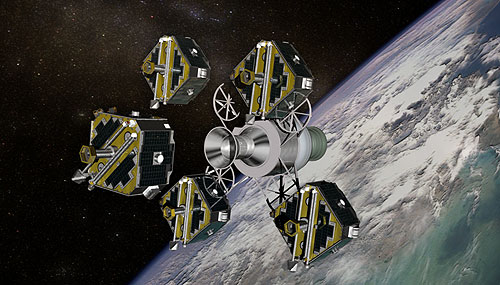Berkeleyan
 An artist's concept of the release of the five THEMIS probes from their carrier. After launch, the probes will take 10 months to coast into the desired orbits around Earth, lining up along the planet's magnetotail every four days. (Image courtesy NASA) |
THEMIS mission to field five made-in-Berkeley space probes
The goal: to solve the mystery of the auroral 'substorms' that cause majestic cosmic light shows
![]()
| 31 January 2007
On Thursday, Feb. 15, five identical space probes built by scientists at the Space Sciences Laboratory (SSL) will be launched into orbit from Cape Canaveral, Fla. Their goal is to help scientists solve a decades-long mystery about the origin of magnetic storms that turn the green, shimmering curtains of Earth's Northern and Southern Lights into colorful, dancing light shows.
The five probes comprising the two-year Time History of Events and Macroscale Interactions during Substorms (THEMIS) mission are the largest number NASA has ever attempted to launch on a single rocket.
Just as weather storms are punctuated by lightning and thunder, so storms in the magnetic field surrounding Earth are punctuated by sudden releases of energy, called substorms, which generate from 10 minutes to hours of frenetic activity in the aurorae.
"For more than 30 years the source location of these explosive energy releases has been sought after with great fervor. It is a question almost as old as space physics itself," says THEMIS principal investigator Vassilis Angelopoulos, a research physicist at SSL. "A substorm starts from a single point in space and progresses past the moon's orbit within minutes, so a single satellite cannot identify the substorm origin. The five-satellite constellation of THEMIS will finally identify the trigger location and the physics involved in substorms."
After launch, the cloned probes will coast in Earth orbit for 10 months until they line up within Earth's shadow like a string of beads. By February 2008 they will begin collecting coordinated measurements every four days, to pinpoint where and when substorms begin, a feat not possible with previous single-satellite missions. Angelopoulos expects that the probes will observe more than 30 substorms during the mission's lifespan.
The ultimate cause of the aurorae and auroral substorms is the sun, which crackles with flares and violent explosions called coronal mass ejections that send charged particles hurtling into space. When these particles pass by our planet, the particles flow around Earth along the planet's magnetic field lines and down the "magnetotail" in Earth's shadow.
Some of these particles leak into Earth's magnetosphere and arc through the atmosphere toward the poles, colliding with air molecules and making the atmosphere glow like a neon light. From space, the glow is like an oval halo encircling the north and south magnetic poles. Periodically, however, energy builds up until Earth's magnetic field breaks, releasing a sudden burst of electrical current that turns the green aurora purple, red, and white and makes it shimmy and shake.
"Substorms are what make the aurorae interesting," says John Bonnell, a plasma physicist and aurora specialist with THEMIS. "Without them, the greenish white sheets are static, like a cloud. Substorms make the sheets ripple and create different colors, such as red borders and colorful edge effects."
The chicken or the egg?
The big question for THEMIS is: What is the sequence of events that triggers these auroral eruptions? One theory proposes that the solar wind disrupts a sheet of moving charged particles about 10 Earth radii down the magnetotail, triggering the eruption and, a minute later, causing Earth's magnetic field to cross-link or "reconnect" with the passing solar wind magnetic field. A second theory proposes that magnetic reconnection happens first, at about 25 Earth radii, which then disrupts the sheet of current to trigger the substorm a couple of minutes later.
THEMIS is named after the Greek goddess of justice, often called "blind justice," because it will impartially decide which comes first, current disruption or magnetic reconnection. Spread out along the magnetotail, THEMIS will time the sequence of electrical discharges and magnetic-field changes, and coordinate with ground-based cameras spread over Alaska and Canada, to discover the time history of these events, perhaps resolving the mystery within months of going online.
"THEMIS is so important," says Angelopoulos, "because the same fundamental physical process is seen around all planets; it happens on the sun in solar flares, and in astrophysical systems such as black holes. It's amazing that being so close to us, here at Earth, it is not understood yet."
The 20 All-Sky cameras and the ground-based observatories housing their acquisition systems were built by the SSL team. Sixteen of these observatories were installed across Canada by University of Calgary scientists in places like Inuvik, Whitehorse, Prince George, Goose Bay, and at the Ekati Diamond Mine, while another four were installed in Alaska by SSL.
In addition, UCLA scientists have buried $20,000 ground-based magnetometers near 10 schools across the northern United States, so that grade-school students can participate in THEMIS experiments and learn, through specially designed curricula, about magnetism and Earth's interactions with the sun.
On Feb. 2, the probes will be trucked to Cape Canaveral to be mounted atop a Delta II rocket in preparation for a Feb. 15 launch.
For more information about THEMIS, visit sprg.ssl.berkeley.edu/themis. To view a video interview with SSL scientists working on the THEMIS mission, visit webcast.berkeley.edu:8080/ramgen/events/publicaffairs/themis.rm.

